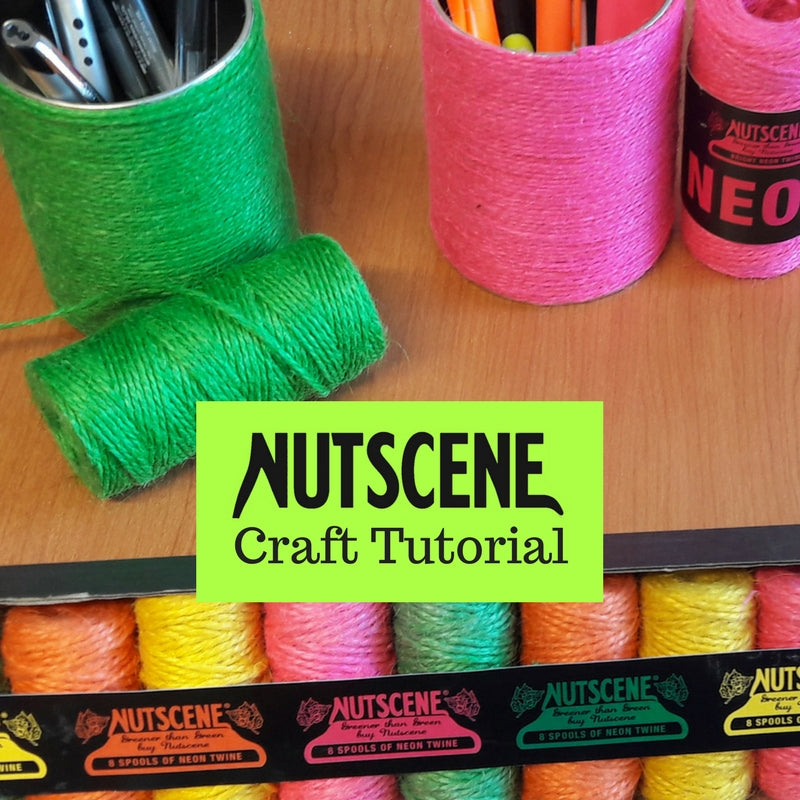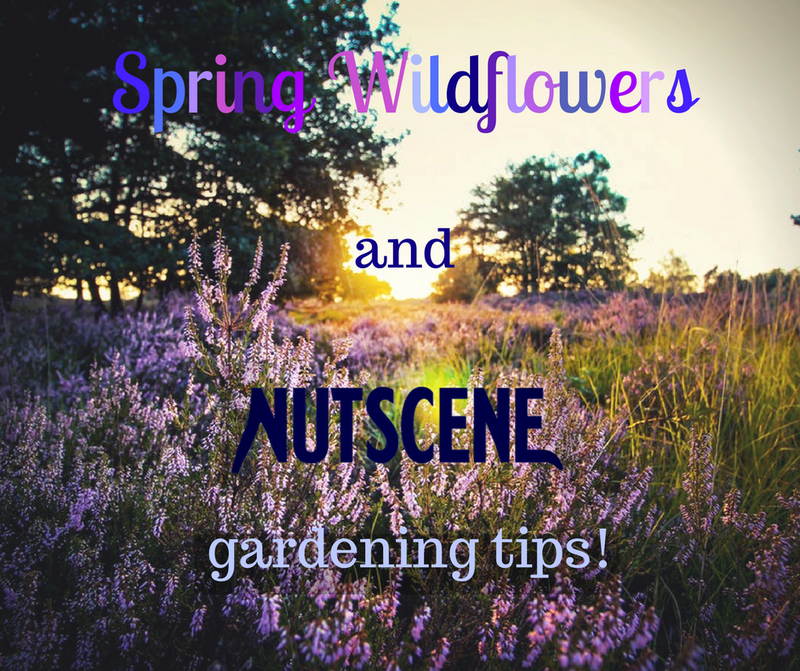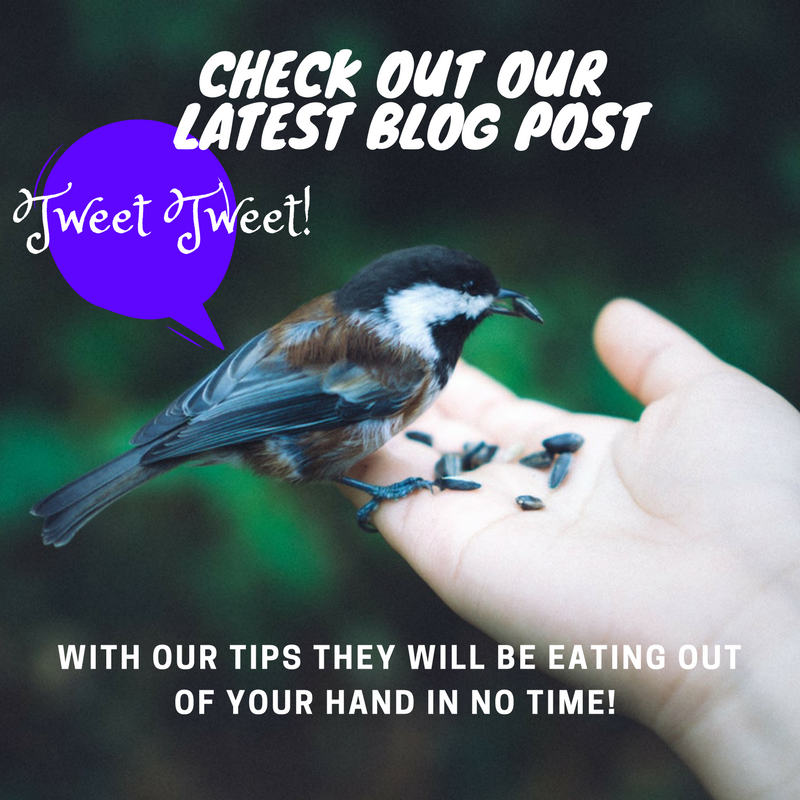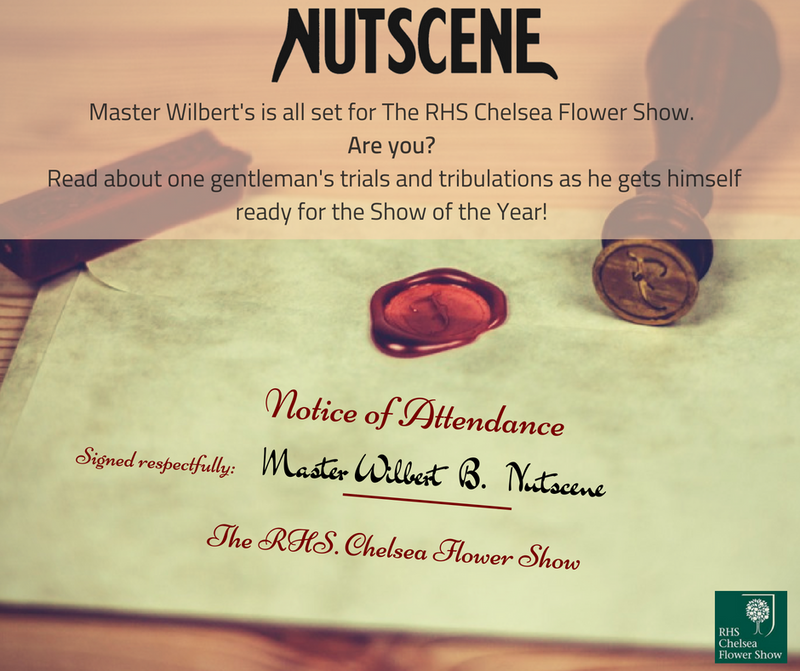
by Shona Young
Nutscene 1922 presents "DIY Desk Tidy Twine Tutorial"
Nutscene 1922 have released a tutorial on how to replicate their Neon Twine Desk Tidy in 6 simple steps.

by Shona Young
Nutscene 1922 presents "DIY Desk Tidy Twine Tutorial"
Nutscene 1922 have released a tutorial on how to replicate their Neon Twine Desk Tidy in 6 simple steps.

by Shona Young
Spring Wildflowers and Nutscene's gardening tips!
Spring is here! And there is nothing nicer than seeing the regrowth of greenery and the flowers starting to bud. This week, Nutscene are looking into Britain's favourite wildflowers. We are also including some tips and tools so you can get the best out of your gardens over the spring period (you can thank us later!) 1. Ramsons (Allium ursinum) Ramsons (also known as wild garlic) are often seen acting like a beautiful white carpet across many forest floors throughout the UK in Spring. Often you can smell the Ramsons' perfume before you see them! This plant prefers woodland and can often be found in the damper areas. Flowering usually takes place between April and June. Little tip: If you are going to cook with Ramsons, it is best to do so when the plant is young. Now that Spring is here, the real preparation needs to be made to ensure that your garden is fully ready for the delights of the warmer months. We recommend our Linen and Leather Gardeners Apron to ensure that you have all the right tools with you, when gardening season hits: Heritage linen and Leather Gardeners Apron Our handmade half length waist apron combines tough durable linen with our dark brown leather. Beautifully made in the UK, this quality apron is what every gardener is crying out for, allowing you to keep necessary tools and twine close whilst concentrating on the job in hand! Just perfect for storing your tools (or phone) with a secure zipped pocket. Size can be adjusted with a webbing waist strap and buckle. It's a super gift for any gardener, muted colours means it's ideal for the man or woman in your life. Click here for more information. As Spring approaches, it is often a good idea to go around your flower beds and paths to clear the area. Pruning the old growth and refreshing the soil can really help your garden get into shape for Spring. 2. Primrose (Primula vulgaris) This is another popular woodland flower that is admired during spring. This plant grows best in shaded spots and prefers moisture. This is one special plant, as it even has a day where it is celebrated across the UK - which is the 19th April in case you were wondering! Both the leaves and the flowers of primrose are edible. Fresh flowers are used in wine whereas dried leaves tend to be used in the process of tea making. Old english folk lore says that if a child eats a primrose that they may see a fairy! 3. Wild Daffodil (Narcissus pseudonarcissus) This is another spring favourite that gets a lot of attention! Often abundant in damp pastures or through woodland, these distinctively shaped flowers are appreciated each Easter. It is important to be careful with the watering of these plants, as over watering can result in the rotting of the bulbs. These plants also go by another name depending on where you are from - in England, they are often referred to as Lent Lillies. Daffodils are symbols for couples who are reaching their 10th year wedding anniversary. It is a known tale that presenting 1 daffodil to someone is a gesture of bad luck - so remember, always have more than one at the ready! As our favourite plants and flowers start to return to life again, sometimes these plants can get a mind of their own! Before you know it- they have grown arms and legs and are taking over their designated area. We recommend our Gardeners Gift Set to help you keep your growing greenery in check! Essentially Nutscene, Gardeners Gift set in Vintage Style Packaging A Gardeners essential gift set of practical and useful Nutscene products. Each set contains our Classic Nutscene Garden Twines in Green and Natural jute. The Greentwist Twine is 2 ply , 100 m in length, The Natural Twine is 3 ply 80 m in length. A set of four wooden plant labels, a mini dibber (Dibblet), and a pair of our vintage style flower snips. Click here for more information. Spring is the perfect time to potter about and to sort out some of the odd jobs. Do you have a plant support that has seen better days, a broken trellis -now is the time to fix this. It may also be a good idea to cordon off the area that you want specific plants to grow in this year. This can help you assess how the plants are developing as the year progresses. 4. Bluebell (Hyacinthoides non-scripta) These distinctively blue flowers are easily recognisable as a clear sign that Spring is here! Bluebells love shade and damp soil. If you keep your eyes peeled, you might spot a rare type of bluebells. This bluebell is white in colour because it lacks the blue pigment. When you next have the joy of slowly strolling past Bluebells growing in abundance, think of this - around half of the world's Bluebell population grows in Britain. There is a Bluebell myth that says if you were a wreath of Bluebells around your neck that you cannot tell a lie. Haws® Metal Indoor watering Cans Haws ® indoor metal cans are available in 3 colours. Supplied with a removable brass rose, making it a versatile indoor can for watering small plants, pots and seedlings. Handcrafted from powder coated steel in our 100 year old traditional shape & delivered in a Haws gift box. These cans are extremely practical for the home, conservatory or greenhouse... and what's more look beautiful. Click here for more information. It is the time to really get prepared, and making sure you had a good quality watering system in place is important. Many new flowers need lots of hydration. Also if you are intending on tackling some bald spots within your grass by planting some grass seed - remember that this will need substantial watering to help the seeds bed in! 5. Wood Sorrel (Oxalis acetosella) Wood Sorrel are recognised by their small white flowers. These plants enjoy woodland ground in shaded moist spots. These flowers can be identified by its three heart-shaped leaves. The Sorrel stems and leaves tend to have a tangy or sour lemon flavour. This plant is rich in Vitamin C and Vitamin A. Sorrel can be used to help a range of health issues such as a sore throat. Sorrel blooms during the spring and summer months. These flowers attract bees, butterflies and flies. As your flowers and plants really start to thrive, remember not to forget about them. They still need your love! It might be watering, dead-heading or just checking as to whether the insects have been attacking them - but don't leave them to their own devices! We hope you enjoyed this blog and some of our tips. Do you have a favourite wildflower that we didn't mention here? Let us know! Lots of Love, The Nutscene Team

by Shona Young
The Art of Macramé and we introduce "Mac-Cramy!®"
Macramé is having a serious moment in the spot-light right now and we, at Nutscene are loving it! Some trends are a simple flash-in-the-pan. 90s Platform shoes and the Harlem Shake spring to mind! However Macramé has a rich history that spans generations, oceans and continents. The Nutscene team took some time to find out more... A Brief History of Macramé It seems that there many different types and variations that all fit under the Macramé craft. Essentially Macramé is the creation of a textile through a knotting process. Back to the Start Where did Macramé come from? Well, there seems to be some controversy as to where this craft originated from. Some sources suggest that the craft originated from 13th century Arab weavers, whereas other records indicate that the craft initiated in China. It is believed that the art was then taken to Spain and from there spread across Europe. Records indicate that Macramé wasn't introduced to Great Britain until the 17th century. Ship-a-hoy! However it is generally accepted that sailors play an important part in the tale of Macramé. It seems the craft was widely used by sailors. With many hours on the sea, the sailors would create items such as rope ladders, hammocks, bags and belts. It is thought that European sailors in particular, helped with the spread of Macramé's popularity, by showcasing their crafts to the various lands that they traveled to. Perhaps even selling or bartering their Macramé craft in exchange for other items when they docked. A Victorian Manner Victorians also indulged in the craft, often with the particular aim of embellishing their homes. Homemaking was often encouraged in Victorian society and Macramé was seen as a respectable hobby for wives and daughters. The craft was fortified when members of the Royal family also gave it their approval. Moving on up! A huge revival was seen in the 1970s. You might have struggled to find a home in Britain in the 1970s that didn't have the obligatory macramé pot-hanger as featured in the picture below! There was a boom for books containing patterns and instructions on how to tackle macramé projects. Macramé was used to make wall art, clothing, table dressings, curtains, plant hangers, chairs... To say it was hugely popular - might be an understatement! Today Today, Macramé is back on in the world of fashion and design (Woohoo!). Macramé is being used in a wide sense- from home interiors to jewellery crafts. We are delighted to see Macramé plant and candles holders coming back in force. These can be beautiful to look at and instantly invite someone into a room. And as if you needed another reason to fall in love with a roof hanging plant holder - If you are like us, and have feline invaders in your home - it can be an ideal way to keep your plants up high or away from tables so they can't have a little chew! We think this kitty might be away to do just that! For the really ambitious, they can always try and tackle a macramé swing chair Seriously though, who wouldn't love an actual swinging chair in their home!? For those who prefer to walk before they can run.... a macramé bracelet could be the perfect place to start. At Nutscene, we love to support all our fans and friends in their projects. We are delighted to announce that we have released our very own Mac-Cramy Twine®. Our Mac-Cramy® twines are from 100% recycled cotton and come in either fine or thick twine - perfect for whatever project you decide to embark upon... We have gone for classic yet versatile colours: including chocolate brown, natural, black, dark blue, grey and mustard in 2 different sizes. Not sure where to start - Don't worry! There are a number of blogs and social platforms that offer really good tutorials or tips for getting started! In creating this blog, the Team at Nutscene read a wide collection of sources on the history and development of the craft of Macramé. Here are some really great sources that we read on the topic: http://macramebracelets.com/history-macrame http://www.ancientearthhealing.com/history-of-macrame/ http://macramecollective.com/news/?p=553 http://www.macramelovers.com/blog/macrame/origin-macrame-journey-world/ Lots of Love, The Nutscene Team

by Shona Young
Turn your garden into a bird watching haven with Nutscene®
We are delighted to say that it is finally starting to feel like Spring at Nutscene. The sun is out and we can faintly hear the birds tweeting away! This Blog will be discussing our favourite UK birds and how you can help them over the coming year. We have an array of tips, from favourite foods, nesting preferences to their ideal landscapes. Bird Care Kit - Made from Recycled Yoghurt Pots Love the sounds of little birds tweeting away? Check out our Bird Care Kit. Having a fat ball/bird cake feeder is a great way of attracting birds to your garden and ensures birds in your area remain fit and healthy. The bird cake kit contains a cake mould to hold the bird cake in place whilst the birds feed. The kit also contains enough suet and bird seed for you to create your first batch of cakes. After that, have fun creating and testing your own bird cakes! At Nutscene we really care about the environment. We are proud to say that this product is made from recycled yoghurt pots, making this the perfect gift for any environmentally conscious gardener and bird enthusiast. This quirky set includes: Suet Seeds, Recipes and Instructions and a Guide to which seeds attract which birds and a unique cake mould/feeder! Click here to see more... Blue Tits Blue Tits are often easily recognised as they known for being frequent visitors to bird tables and feeding stations! Here are some interesting tidbits for blue tit lovers: Blue Tits like to eat insects, nuts and fruits and can often be found snacking on hanging feeders that have mixed bird feed! They are known to breed happily in nest boxes. The below Bird Bothy makes the perfect home for blue tits, as they prefer homes with a narrow entrance. These little birds, whilst common, are stunning little creatures that are protected by The Wildlife and Countryside Act 1981. Bird Bothy - A home for little birds! Have a look at our adorable Bird Bothy! This lovely, yet practical Bird House is perfect for little birds seeking a place to nest and to raise young. Made in the UK from Plywood. The Bothy (a Scottish word for a small hut or hideaway) will help in attracting smaller species into your garden and protecting them - so they can concentrate on the job at hand. The flat pack bird house consists of two 1.5mm plywood parts which require assembly with a little creativity. Whilst following the instructions provided to assemble your bird house you are encouraged to add your own personal touch from the colour you finish the house in, to the items you find to secure it, such as matchsticks. The bird house is packaged in a cardboard sleeve, just the right size to fit though a standard letter box. Blue Tits, Great Tits, Coal Tits, Tree Sparrows and Pied Flycatchers all welcome in this man-made refuge! This little Bird Bothy has been designed without a perch and with a hole diameter of 28mm, which prevents smaller birds being antagonised by larger ones. A lovely gift for anyone who loves and protects our diminishing bird population. Click here to see more... Swallows Swallows are beautiful little birds that are known for their agile and energetic flight, yet quiet nature. Interestingly, male and female swallows tend to look virtually identical. Here are some other key pieces of information for swallow fans: Swallows tend not to eat at fixed bird feeders. Swallows prefer small insects and tends to go for open gardens with longer grass. These birds usually live beside water. Moving water such as water features and bird baths have been used by some fans to encourage swallows. Due to swallows facing difficulties with their habitats, these birds now have an Amber Conservation Status. ECO Bird Feeder - Designed and Manufactured in the UK If you need a bird feeder then here's a simple and elegant way of recycling unwanted food to your local wildlife. Have fun experimenting to see which birds are attracted by certain foods. Dimensions 95x120mm. This Bird Feeder also comes with a guide to all of the types of food you can try! Click here to see more... We recommend that apples and pears go down a treat with Robins and Thrushes! Peanuts are loved by finches and woodpeckers. Thrushes Thrushes tend to be known as songbirds. They were known as one of the most common birds in Britain around a 100 years ago, however they have now become quite a rare sight. Here are some facts for thrush enthusiasts: There are 4 types of Thrushes that regularly breed in the UK. They are particular fans of seeds, insects and fruit and prefer to eat off the ground- so gardens that don't have pesticides or insecticides are your best bet. They are one of a few British birds that eat snails. Thrushes enjoy bathing... a lot... so a shallow bath not too far from the ground is ideal for them. Bird Feeding Table - Made from Recycled Plant Pots in the UK Our Bird Feeding Table is a food waste table that has been designed to enable leftover household food to be easily offered to the birds in your garden, rather than having to buy expensive "off the shelf" food. Made from recycled plant pots, collected through our UK wide 'pot to product scheme', the food waste table provides a clean and practical way of offering unwanted food to your needy little neighbours. Comes ready to hang in the garden with string. Just add the food! Click here to see more... Yellow Hammers Sadly, Yellow Hammers have become an extremely rare sight nowadays. Due to the many difficulties that their species face, these birds now have an Red Conservation Status. Here are some data on these exceptional birds: These birds enjoy open gardens and hedgerows. When found, they are likely to be sitting on top of a hedge or fence post singing! Yellow Hammers enjoy a varied diet including seeds, blackberries and spiders. These birds taken an equal share of the chores, with both male and females bird taking responsibility for feeding their young. Starlings Another bird that also has a Red Conservation Status are the Starlings. These birds are known for their fast flight and confident walk, but what you might not know is that they can be quite noisy! Starlings enjoy wide open country landscapes. These stunning birds are known for their murmurations: where large numbers of the birds display their talents through spectacular flying shows. They enjoy insects, seeds and fruit. A favourite treat of theirs seems to be peanut cake! Be careful though, due to the starlings' nature, there is a complaint that starlings are caught swooping down and completely clearing a bird feeder of all food in minutes! Are you a fan of bird watching? Is your garden a bird watching haven? Do you have any pictures that you would like to share - get in touch! We love to hear from you! Lots of love, The Nutscene Team
by Shona Young
Twine Lovers: Check out these top 5 Craft Projects for 2018!
The Nutscene Team have prepared a selection of their favourite twine crafts for 2018. From little to large - there is a project here for every type of crafter.

by Shona Young
Wilbert's Notice of Attendance - The RHS Chelsea Flower Show 2018
Master Wilbert has been very, very busy preparing for The RHS Chelsea Flower Show... Find out exactly what Wilbert packed for the show, as well as where Wilbert can be found at the greatest flower show in the world!